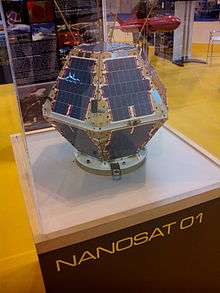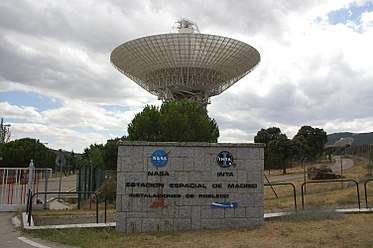Instituto Nacional de Técnica Aeroespacial
The Instituto Nacional de Técnica Aeroespacial (INTA, National Institute for Aerospace Technology) is an autonomous research agency of the Government of Spain responsible for the state aerospace, aeronautics, hydrodynamics, and defense and security technologies research.
| Instituto Nacional de Técnica Aeroespacial | |
 | |
| Agency overview | |
|---|---|
| Formed | May 7, 1942 |
| Jurisdiction | Spanish Government |
| Headquarters | Torrejón de Ardoz, Spain |
| Employees | 1,976 (2019) |
| Annual budget | |
| Agency executives |
|
| Website | www.inta.es |
The INTA was established in 1942, as the Instituto Nacional de Técnica Aeronáutica (National Institute of Aeronautics), and it was integrated in the Ministry of the Air.[1] It has its headquarters in Torrejón de Ardoz, near Madrid.
Organization
Its budget, €190 million in 2019, comes from the Spanish Ministry of Defence and from its own projects with the industry. As of 2017 INTA had a total of 1500 employees,[2] 80% of them are dedicated to R&D activities.[3]
Its two main areas of activity are research and development (for example, in propulsion, materials, remote sensing) and certification and testing (for example, in aircraft, software, metrology).
Programs and missions
Satellites
Main objectives of the Nano-satellites and Mini-satellites programmes;
- R&D programmes in the field of small satellites from 20 kg to 150 kg started in 1997 after MiniSat-1 launch, to keep running internat space activities at INTA.
- The systems and subsystems are mainly developed at INTA with collaborations in the R&D work with several universities and other institutions in Spain
- Development of multimission Service Modules compatible with available launchers: up to 150 kg and 60x60x80cm.
- Other specific tasks or satellite units to the small business Spanish industries, to encourage their participation in space technology.
- Give flight opportunities to the Spanish research community at an affordable budget target each 3–4 years, for new experiments and instruments, in orbit demonstration technologies, earth observation and space exploration from Low Earth orbit.

Satellite programmes:
- Intasat-1 INTA launched its first satellite, the Intasat-1, on 15 November 1974, aboard a NASA Delta rocket.[4]
- LBSAT was launched on Ariane 4 on 7 July 1995.[5]
- Minisat 01 Next satellite in orbit was Minisat 01, with its 190 kg it was launched on board of a Pegasus rocket[6] over the Canary Islands in April 1997.
- Nanosat 01 project was created to continue with the Spanish space program of low cost satellites. It was finally put into orbit by the Ariane 5 launch vehicle in December 2004.
- Nanosat 1B It was only 5 years after when Nanosat 1B .[7] was launched on board of a Dnepr. Parallel to this research activity, a new research line was opened with MicroSat-1, which is a bit heavier at just above 100 kg and was scheduled to be launched in early 2012. NanoSat-2 SeoSat (Spanish Earth Observation Satellite) are also part of the INTA R&D projects.
- Xatcobeo launched in 2012. Developed in collaboration with Agrupación Estratéxica Aeroespacial (currently Alén Space).
- OPTOS Launched in 2013, is the most recent addition to INTA's small satellites line.[8] OPTOS is based on the CubeSat standard (a 3U platform) but goes far beyond the usual approach for this kind of satellites. It was designed, developed and tested with a completely professional methodology as it is conceived as a technology demonstrator with the target of proving that a satellite of that size can carry out dedicated missions as bigger satellites. It was launched in November 2013 by means of a Dnepr rocket[9] and has been successfully active in orbit since then.
- Paz observation and reconnaissance satellite launched on 22 February 2018 operated jointly with Hisdesat
- Ingenio optical imaging satellite
- Anser
All these satellites are totally Spanish in manufacture and design, comprising a low-cost multiuse platform, with modular design subsystems and standard interfaces with the payload module.
Launchers
INTA designed atmospheric sounding rockets such as:
- INTA-255
.jpg) A Capricornio's duplicate.
A Capricornio's duplicate. - INTA-300
- INTA-100[10]
- Capricornio
- Pilum
These operate from the El Arenosillo rocket launch site.
Aircraft
Instruments
- Raman Laser Spectrometer (RLS) for detecting minerals and potential biological pigments for the ESA's Rosalind Franklin rover[12]
- Mars Environmental Dynamics Analyzer (MEDA) which will ride on NASA's Perseverance rover[13]
- Rover Environmental Monitoring Station (REMS) for the Curiosity rover
- Temperature and Winds for InSight (TWINS) on the InSight mission
- Signs Of LIfe Detector (SOLID) to be flown in a future mission (current proposal is Icebreaker Life mission)
Other projects
- Artemisa
Facilities

This is an incomplete list of facilities:
Technological campuses
- INTA's headquarters in Torrejón de Ardoz, where the General Sub-directorates of Aeronautical Systems are located
- Campus of La Marañosa, in San Martín de la Vega, base for the General Sub-directorate of Naval Systems
- Campus of El Pardo, in El Pardo, base for the General Sub-directorate of Terrestrial Systems
Testing facilities
- Rozas Airborne Research Center (CIAR) in Castro de Rei, Galicia
- Cuadros Testing Laboratory in Cuadros, León
- General Marva Laboratory of Army Corps of Engineers (LABINGE) in Madrid
- Flight Experimentation Tests for Aircraft Certification in Chauchina, Granada
- Torregorda Testing Centre (CET) in Cadiz
- Airbus A400 Development Efforts in Seville
- INTA Turbojet Engine Test Centre (TETC INTA)
Tracking and launch sites
- El Arenosillo Test Centre is a rocket launch site in southern Spain
- El Hierro Launch Centre project for a spaceport in El Hierro
- Madrid Deep Space Communications Complex shared with NASA in Madrid
- Maspalomas Station
- Cebreros Station
- Villafranca Station
- GNSS Service Centre in Madrid
Other facilities
- Spanish Astrobiology Center shared with CSIC
See also
References
- "BOE.es - Documento BOE-A-1980-777". www.boe.es. Retrieved 16 February 2020.
- "Archived copy" (PDF). Archived from the original (PDF) on 3 September 2019. Retrieved 3 September 2019.CS1 maint: archived copy as title (link)
- "Inta en Cifras" (in Spanish). Instituto Nacional de Técnica Aeroespacial. Archived from the original on 24 June 2008.
- "INTASAT (NSSDC ID: 1974-089C)". National Space Science Data Center Master Catalog. National Aeronautics and Space Administration. Retrieved 3 November 2008.
- "Archived copy". Archived from the original on 6 July 2012. Retrieved 20 August 2012.CS1 maint: archived copy as title (link)
- Pegasus (rocket)
- "NanoSat programme". Archived from the original on 1 December 2009.
- "OPTOS, el primer picosatélite español" (PDF) (in Spanish). Instituto Nacional de Técnica Aeroespacial. Archived from the original (PDF) on 4 November 2013.
- "OPTOS, un pequeño gran satélite 'made in Spain'". El Mundo (in Spanish). Spain.
- http://pt.scribd.com/doc/53619168/34/The-INTA-100-Sounding-Rocket
- https://www.defensa.com/en-abierto/entrevistamos-teniente-general-jose-maria-salom-director-general
- http://www.cab.inta.es/es/noticias/283/el-espectrometro-laser-raman-rls-en-exomars
- http://www.cab.inta.es/es/noticias/169/meda-seleccionado-para-mars202031-07-2014
External links
| Wikimedia Commons has media related to Instituto Nacional de Técnica Aeroespacial. |
- INTA Official Site (in Spanish)